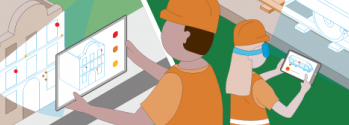
Our Challenge
To support a flourishing society, economy and natural environment, substantial changes must occur across our cities and infrastructure in order to enable them to be more energy and material efficient, to be more durable and resilient in the face of climate change. In order to achieve this, we needed to explore new ways of collecting and interpreting data to better understand where improvements can be made.
Our Solution
CDBB’s research programme explored the tools and processes by which we can monitor and measure the built environment and how we use it.
Projects within this theme
| Projects in this theme | Lead researcher |
|---|---|
|
Precision Engineered Timber - Digital design and delivery of healthier schools Unlocking the potential of timber for use in off-site, manufactured, large-scale school buildings through the deployment of digital technologies. |
Dr Michael Ramage |
|
Line of sight: an Asset Management Methodology to Support Organisational Objectives |
Jennifer Schooling |
|
Procurement strategies for incentivising collaborative delivery to optimise whole-life outcomes Exploring the connections between successful collaborative procurement and digital technologies, including BIM. |
Prof Campbell Middleton |
|
Application of satellite technology in infrastructure monitoring (Digital Engineering) Taking advantage of satellite monitoring to understand the performance of structures in order to leverage the whole-life value of built assets. |
Prof Campbell Middleton |
|
Staffordshire Bridges - Long Term Performance Monitoring using Fibre-Optic Sensors Demonstrating how fibre-optic strain monitoring can rationalise performance, maintenance and preservation of bridges. |
Prof Campbell Middleton |
|
Digital Modelling of the Evolution of the Built Form in Britain Visualising the evolution of the built form in Britain, including changes in land use, buildings and transport infrastructure to foster development and regeneration. |
Dr Ying Jin |
|
Energy Planning for Resilient Decarbonization Integrating data spanning environmental features, physical form, land use, socio-demographics and economics for efficient energy planning and sustainability. |
Dr Ruchi Choudhary |
|
The Edge: a case study and template for BIM 2 A case study showcasing BIM and its long-term benefits for the built environment. |
Dr Michael Ramage |
|
Case Study: Platform approach to design for manufacture and assembly Discovering the benefits, value and innovative potential of a manufacture-led approach to construction by learning lessons from the manufacturing, automotive and software industries. |
Jaimie Johnston |
|
Pedagogy and Upskilling Network A network that aims to future-proof the British education sector and built industry training by facilitating digital upskilling. |
Prof Jason Underwood |
|
The local governance of digital technology – implications for the cityscale digital twin Digital twins and cities: highlighting the need for better transparency and collaboration in local governance to engage citizens and increase trust of digital technology. |
Dr Timea Nochta |
|
Designing Safe Complex Environments Using the principles of universal design to create a virtual reality environment to test the needs of users with balance and sensory impairments. |
Dr Thomas Stone |
|
Understanding how the UK planning system is engaging with BIM at different spatial scales, from individual buildings through development schemes to city/regional levels. Exploring how to deliver BIM and inform local and national policymakers. |
Prof Phil Allmendinger |
|
Addressing how European cities are adapting to BIM, including drivers and barriers; considering their awareness of digital technologies in future planning and strategies, particularly around Smart Cities. |
Dr Franziska Sielker |
|
Machine Learning and AI in the Built Environment Improving the foundations for applying tried-and-tested machine learning (ML) approaches to the built environment by reducing the cost of creating and deploying ML systems. |
Dr Thies Lindenthal |
|
Crowdsourcing Data in Mining Spatial Urban Activities Understanding how check-in data from social media is distributed around Cambridge, UK, and what kinds of spatial segmentation can be identified. Pilots were compared with a prior study of Ningbo in China for an international perspective. |
Dr Elisabete Silva |
|
Visualising the Future: Big Data and the Built Environment Examining the future use of big data in the built environment with contributions from experts from academia, government and private companies. Analysing the barriers and challenges – budgetary, technical and privacy. |
Prof Paul Linden |
|
Adaptive Design of Supported Excavations This workshop highlighted the need to develop the technology to be more reliable, the skills to operate Observational Method tools, the standards to underpin these and a body of open-access case studies of good practice. |
Dr Giovanna Biscontin |
|
Exploring what questions are City Information Modelling (CIM) and Building Information Modelling (BIM) best suited to answer. Exploring barriers to adoption and how data can complement or enable CIM in the UK for effective and sustainable future city development. |
Dr Franziska Sielker |
|
Co-Evolving Built Environments and Mobile Autonomy for Future Transport and Mobility Tackling the challenges of autonomous navigation, which are compounded by the unpredictability and dynamics of urban environments. |
Dr Amanda Prorok |
|
CAR: creation and through-life management of built assets and infrastructure The final report of a CDBB study called “Defining the Research Agenda and Research Landscape for Digital Built Britain”. It categorises four emerging types of digital technology in the built environment - as-is reality capture, on-going reality capture, information management and sharing, data-driven decision making – and offers recommendations for developing and implementing these technologies. |
|
|
UIL: integration and optimisation of services embedded in the built environment Exploring the capabilities required to specify, procure, design, deliver and manage services based on, and embedded in, the built environment to optimise efficiency and productivity for their stakeholders, whilst making best use of data and information. |
|
|
UIL: Making the digitally enabled services and supply chain Identifying the capabilities needed by the government, by those involved in the specification, design and delivery of built assets and across a portfolio of services, through-life, for businesses and citizens, with a focus on how to best derive value. |

